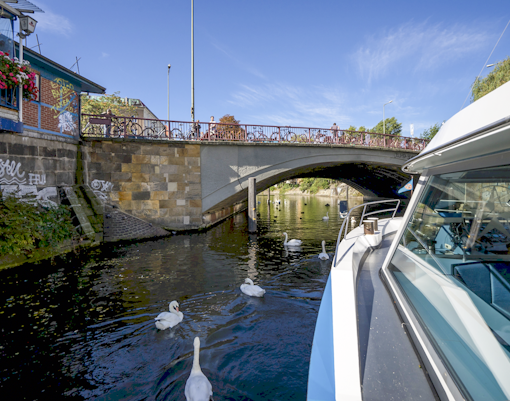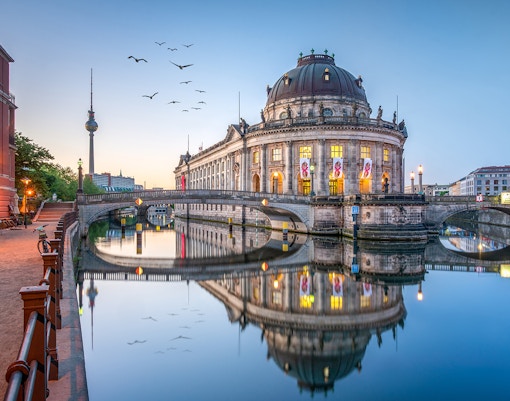- Berlin TV Tower
- Friedrichstadt Palast
- Tropical Islands
- Illuseum Berlin
- Sachsenhausen Concentration Camp
- DDR Museum
- Panoramapunkt Berlin
- Big Bus Berlin Hop-on Hop-off Tours
- City Sightseeing Berlin Hop-on Hop-off Tours
- Reichstag Tours
- Berlin Wall Museum
- Berlin Welt Balloon
- Berlin Icebar
- Madame Tussauds
- Samurai Museum Berlin
- LEGOLAND Discovery Centre Berlin
- Fotografiska Tickets
Quiet routes through Berlin: The canal way
Why explore the historic Berlin canal?

Explore Berlin beyond the usual
The canal winds through Kreuzberg, Neukölln, and Moabit, passing backyard docks, café boats, artist studios, and quiet paths along Paul-Lincke-Ufer and Maybachufer. In short, it offers a closer look at local life beyond the central tourist routes.

Architectural contrasts from the water
Boats pass under several distinctive bridges including Lohmühlen Bridge, Schilling Bridge, Lichtenstein Bridge, and Cornelius Bridge. These span over different architectural eras, from 19th-century stone designs to early 20th-century steelwork. Along the route, you’ll also spot pre-war tenements, modernist buildings, and industrial facades turned into cultural venues.

Layers of history
Cruising the Berlin canal shows how the Landwehr Canal has shaped the city's past through some key historic locations. You’ll pass WWII-scarred embankments near Kreuzberg, sections that once marked the Cold War border, and Moabit’s former industrial buildings now turned into homes and galleries.

Street art and counterculture
Kreuzberg and Neukölln have long been hubs of Berlin’s alternative scene, especially since the 1970s and 1980s when squatting movements, punk communities, and immigrant neighborhoods shaped their rebellious character. The canal walls near Admiralbrücke and Urbanhafen display this legacy through murals, stencil art, and political graffiti, reflecting decades of activism, anti-establishment ideas, and creative resistance.

Wildlife along the banks
Birdlife is common along this route. Herons, cormorants, coots, and mallards are frequent sights, especially in quieter zones near Tiergarten and Urbanhafen. Sometimes, you may even hear nightingales and blackbirds singing from the trees.
What to expect on a Berlin canal tour

Boat size
Unlike wide Spree riverboats, canal tours use smaller, low-profile vessels designed to pass beneath the lower bridges of the Landwehrkanal and its branches. These boats offer a more intimate experience and may have limited onboard amenities.

Seasonal water level changes
Berlin’s canal network is connected to several locks that regulate seasonal water levels. Occasionally, parts of the route may be altered or shortened if water levels are too high or low.

Photographer’s dream
Due to the slower speed and low boat profile, this tour offers perfect angles for architecture photography, especially Berlin’s canal-side art nouveau buildings, bridges, and tree canopies.

Cultural events on the banks
Many canal routes pass by pop-up galleries, flea markets, and canal-cinema events (especially in Kreuzberg). Time your tour to catch these from the water.
What can you do besides cruising the Berlin canal?

Touring Urbanhafen (Kreuzberg)
Once Berlin’s busiest inner-city port, Urbanhafen was an important hub for coal and cargo transport in the 19th century. Today, it’s a green basin along the Kreuzberg stretch of the canal with open lawns and blooming cherry trees in spring. The most popular attraction is the Admiralbrücke, the oldest surviving iron-bridge over the canal. Most evenings, this bridge becomes a neighborhood landmark, where locals gather with drinks and music in a laid-back, communal vibe.

Café-hop in Kreuzberg
Kreuzberg’s canal-side streets are perfect for a relaxed café crawl. From traditional Turkish tea houses to minimalist espresso bars, the area offers a hot-pot of cultures, flavors, and cozy spots ideal for watching Berlin life pass by. Pop-up galleries, street murals, and artist studios are other interesting spots tucked into the neighborhoods waiting to be explored.

Berlin aquarium & Zoologischer Garten
Located at the edge of Tiergarten near the canal, Berlin Zoo and Aquarium offer an interesting wildlife experience just minutes from the water. Home to over 20,000 animals, it’s one of Europe’s oldest zoological complexes.

Boros Bunker / Sammlung Boros
A short walk from the canal near Friedrichstraße lies the WWII-era bunker that now houses Sammlung Boros, one of Berlin’s most compelling contemporary art collections. Behind its five stories of gray walls, you can find a rotating showcase of nearly 700 installations and sculptures.
Plan your visit to Berlin canal
Common boarding points include Friedrichstraße and Pier Alte Börse.
Friedrichstraße Pier
- By train: Take the S-Bahn (S3, S5, S7, S9) or U-Bahn (U6) to Friedrichstraße Station. From there, it's a 3–5 minute walk along the river toward Friedrichstraße Bridge.
- By bus: Bus lines 147 and TXL (when running) stop at Friedrichstraße Station. Walk a short distance to the riverfront pier.
Pier Alte Börse (Old Stock Exchange Pier)
- By train: Ride the S-Bahn (S3, S5, S7, S9) to Hackescher Markt Station. Walk 2–3 minutes along the river toward Monbijoupark and the Bode Museum.
- By bus: Bus lines 100 and 300 stop at Lustgarten or Spandauer Str./Marienkirche. From there, walk through Museum Island toward the pier behind Alte Börse.

Weekday vs Weekend
- Weekdays: Cruises are generally less crowded, making it easier to find a good seat, especially on the upper deck. The pace feels quieter and more relaxed, ideal for those who want to enjoy Berlin’s neighbourhoods without distraction.
- Weekends & Holidays: Expect a more vibrant atmosphere with more families, groups, and tourists on board. Lines can be longer, and popular departures may sell out fast.
Peak Season vs Low Season
- Peak Season (June–August): Warm, sunny days and late sunsets make this the liveliest time for canal cruises. Outdoor decks are open, Berlin buzzes with festivals, and the canal is at its most active. But it’s also when prices and crowds peak.
- Low Season (November–March): Much quieter with fewer cruises in operation, but fares are lower and seating is rarely an issue. The city feels more introspective and is perfect if you prefer a slower pace.
Frequently asked questions about the Berlin canal tour
Yes. While the Spree cruises highlight iconic landmarks like the Berlin Cathedral and Museum Island, canal tours show lesser-known neighborhoods and local Berlin life.
It varies by operator. Common starting points include Friedrichstraße and Pier Alte Börse.
Some boats have onboard cafes or bars and do not allow external food items, while others allow you to bring your own snacks. Make sure to double check cruise guidelines when booking.
Most tours include commentary in German and English, with some offering audio guides or themed narration.
Anything warm and comfy! Bring a light jacket as breezes can be cool even in summer when passing shaded stretches.
On most public boats, yes, if leashed. But it's best to check with the tour operator while booking.
Absolutely! The calm pace and varied scenery make it a good fit for families, though some boats offer fewer kid-friendly amenities.
Not usually. The full canal network is best accessed from spring to early autumn. Winter cruises are rare on the narrower canals.
